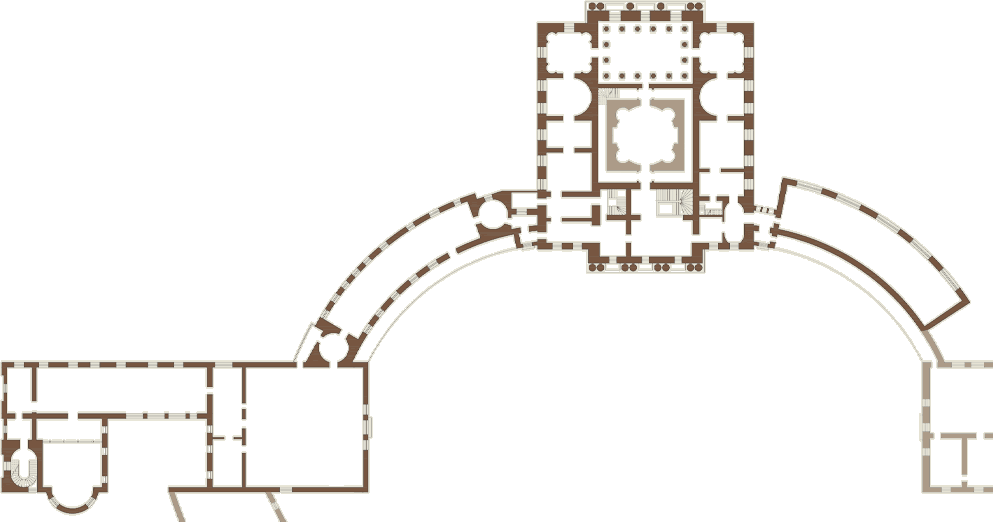The Hall of War
Загрузка панорамы...
Initially, this room was the State Drawing Room of Pavel Petrovich. Its unusual layout in the form of an octagon with niches between the window and door openings and the vaulted ceiling was conceived by Charles Cameron. In 1789, Vincenzo Brenna completed the decoration of the hall, saturating it with a rich stucco decor with the themes of military attributes of the Roman Empire. Relief panels with compositions of military trophies and elements of weapons of Roman soldiers were placed on both sides of niches, window and door openings, which are also arched and seem to be inscribed in the shapes of irregular elongated rectangles. White reliefs on a golden background are impressively combined with a richly decorated gilded stucco frieze and a protruding cornice, stucco caissons, and shells decorating niches. The brilliance of the gilded carving of the door leading to the Northern Suite, and the high floor lamps with fasces, shields, and helmets of Roman soldiers made of carved gilded wood enhance the impression of the solemnity of the hall. Antique marble busts are placed in three niches, and in the fourth, there is a stucco stove topped with the figure of the eagle of the god Jupiter sitting on cannonballs in the flame. As Brenna himself wrote, the decoration of the hall ended by "the plafond I painted myself depicting a dome, from the cornice of which draperies seem to hang. In the eight corners, there are eight large life-size images of war trophies and figures of slaves, also in full size, two on each image. The figures are represented sitting on cannons and thus supporting the drapery fluttering above them. The lunettes contain architectural motifs with figures in the clothes of all four winds.” It was this hall that was decorated in 1796 as the Throne Room of Paul I, so the imperial regalia was kept here. After the fire of 1803, Andrey Voronikhin restored the hall as the State Drawing Room, and, while preserving the main decoration by Vincenzo Brenna, introduced some changes here. The painting on the ceiling was replaced by a vaulted coffered ceiling decorated with stucco and reliefs on the themes of ancient myths by sculptors Semyon Teglev and Mikhail Aleksandrov-Uvazhny appeared in the lunettes. The Hall acquired more severity and solemnity, as there were only two colors now: the dominant white enhanced by the brilliance of gold. New furniture was made in the same style with the decoration, stylized as Roman curule seats, painted in antique green bronze with gilding (recreated based on the preserved original, with authentic Russian embroidery of the early 19th century in upholstery). The natural landscapes outside the windows bring life to the severity of the decoration. According to the plan of Andrey Voronikhin, solid glass was made at the Imperial Glass Factory for the windows of this hall, as well as the Hall of Peace symmetrical to it, to admire the landscape in the window like a picture in a frame. The hall is illuminated by a magnificent French lantern of the 18th century, made of gilded bronze in the workshop of the famous bronzer Pierre Gouthière. In the niches, there are busts of Roman Emperors Septimius Severus (the late 1st century CE), Elagabalus (the early 3rd century CE), and the commander Agrippa (Italian copy of the 18th century from the ancient original). Against the window on the axis with the Greek Hall, is a decorative vase of blue and gold porcelain, made in the early 19th century at the Sevres Porcelain Manufactory, and, according to historical legend, presented by Emperor Napoleon to Alexander I on the occasion of the conclusion of the Treaty of Tilsit. A decorative tripod vase stood against the second window since 1810, made at the Imperial Glass Factory per the drawing of Andrey Voronikhin. However, it was lost during World War II. There is a new tripod now, made by the masters of OOO Studia N. B. Yuzhakovoy, by analogy with the original tripod located in the Hall of Peace. The hall was recreated in 1963 as per the project of S. V. Popova-Gunich. The molding was partially restored and partially recreated using casts from the originals (N. Relkina and I. Kalugin). The carved gilded doors and floor lamps were recreated by V. Polyakin and A. Yankovsky.
The Hall of War on the floor plane
- The Egyptian Vestibule
- The Carpet Study
- The Second Interconnecting Study
- The Main Staircase
- The Hall of War
- The Picture Gallery
- The Upper Vestibule
- The Greek Hall
- The Third Interconnecting Study
- The Italian Hall
- The Hall of Peace
- The Throne Room
- The Valet de Chambre Room of Paul I
- The Library of Empress Maria Feodorovna
- The Pantry
- The Dressing Room of Paul I
- The Boudoir
- The Orchestral Room
- The Rossi Study
- The State Bedroom
- The Knights Room
- The Rossi Library
- The Dressing Room of Maria Feodorovna
- The Chevalier Guard Room
- The Small Study of Emperor Paul I
- The Maid of Honour's Room
- The Anteroom (Turkish Room)
- The State Library of Paul I
- The First Interconnecting Study
- The Palace Church

Back
